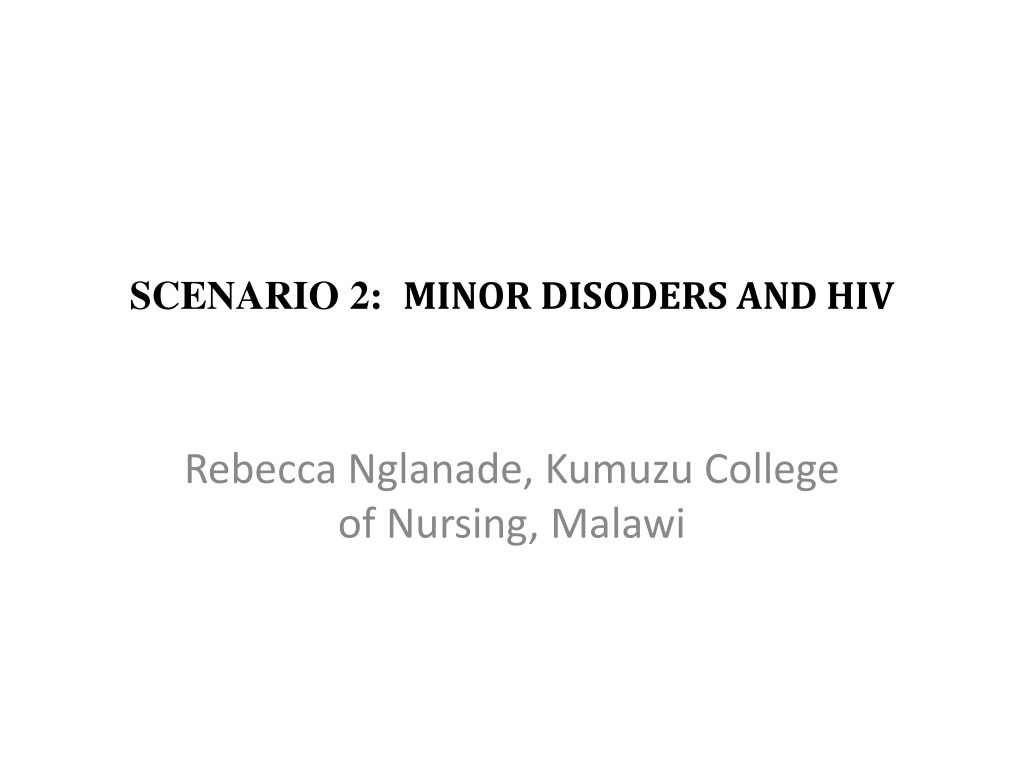Challenges Faced by Pregnant Women with HIV Diagnosis in Malawi
Maria, a pregnant woman in Malawi, faces the challenge of an unexpected pregnancy and a positive HIV diagnosis. The scenario explores her concerns, midwifery diagnosis, preparation for HIV testing, disclosure of results, and maintaining confidentiality in antenatal care. It also delves into factors leading to her marriage, HIV contraction, necessary precautions, and staff attitudes towards HIV-positive mothers.
Download Presentation

Please find below an Image/Link to download the presentation.
The content on the website is provided AS IS for your information and personal use only. It may not be sold, licensed, or shared on other websites without obtaining consent from the author. Download presentation by click this link. If you encounter any issues during the download, it is possible that the publisher has removed the file from their server.
E N D
Presentation Transcript
SCENARIO 2: MINOR DISODERS AND HIV Rebecca Nglanade, Kumuzu College of Nursing, Malawi
Scenario Maria is 30 years old gravida 1 Para 0 has come for her antenatal booking. Her LNMP is 15/07/2013. She works as a High school teacher and married to John who travels extensively because he is a salesman of farm inputs. She has been counseled for HIV testing since she does not know her status. She complains of nausea and vomiting especially in the morning and frequency in micturation for the past 4weeks. She says that her friend advised her to report to the clinic.
History and background information On history taking she has been happily married for 1year now and explains that she did not plan the pregnancy because they had agreed that they will start a family after 2years of their married life as they are responsible for fees of three relatives On physical assessment she is healthy looking and no other abnormalities or danger signs are noted except for the nausea as you observe that she has a small container she uses to spit every now and again
Next steps After counselling, she is tested for HIV and found positive. She is to start on anti-viral treatment. You are providing Mary with all the necessary information on how she and the baby she is carrying remain health. You also want to find out how she will disclose the information to John her husband on his return from his trip. She expresses concern as she recalls that her parents were against her marrying John because the parents were not comfortable with his lifestyle
TRIGGER QUESTIONS: 1. What is the midwifery diagnosis of Maria? 2. What are the issues of Maria? 3. What alerted the midwife to a possible diagnosis of minor disorders of pregnancy and HIV positive status? 4. How are pregnant women prepared for testing for HIV and disclosure of test results? 5. What are possible factors that led to Maria marry John 6. How did Maria contract the HIV? 7. What control precautions will be required for Maria? 8. How is pregnant women confidentiality maintained in antenatal clinic? 9. What are the attitudes of staff towards HIV positive mothers?
ASPECTS OF TOPIC TO BE INVESTIGATED 1. Presentation of mothers at ANC when do pregnant women book for ANC? when do women normally seek health care in Malawi and why? 2. Conditions associated with minor disorders Why is Maria having these minor disorders Physiological basis Management Complications
ASPECTS OF TOPIC TO BE INVESTIGATED 3. Conditions associated with HIV Methods of transmission Infection control measures Testing when, where and how? 4. Diagnosis of HIV what proportion of people know their HIV+ status? Concept of blame related to health status the innocent patient/ how disease transmitted
ASPECTS OF TOPIC TO BE INVESTIGATED 5. Disclosure of HIV status who needs to know and why? 6. Treatment who gives it? where and when? Prognosis 7. Confidentiality 8. Equality and diversity 9. Non- judgmental attitudes
LEARNING OUTCOMES: Students will be able to: Discuss why pregnant women need to book early for ANC Explain the clinical features of common minor disorders of pregnancy Explain the differential diagnosis Explain why people with HIV may be unaware of their status State the methods of transmission for HIV
LEARNING OUTCOMES: Students will be able to: Describe infection control procedures that reduce the risk of HIV infection at family level in the clinical area in the community Discuss fears of patients and staff regarding HIV transmission Explain the nurse s duty of confidentiality Discuss when disclosure of HIV status is advisable Describe the care of a patient admitted to hospital with acute abdominal pain
























